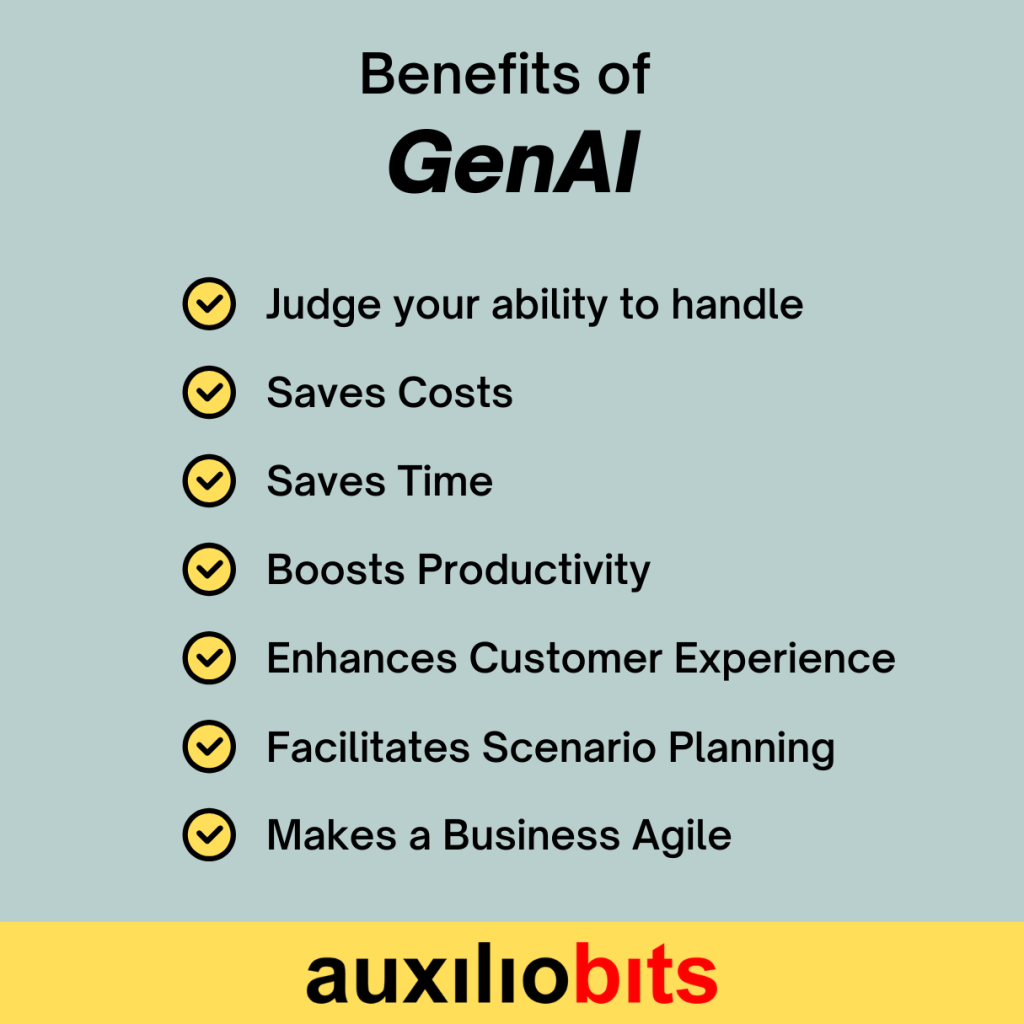
Key Takeaways
- Generative AI is a category of AI (Artificial Intelligence) in which algorithms can be modeled to generate new content, such as images, text, audio, or even videos, that mimic human-like creativity and decision-making.
- It offers a myriad of benefits to a business like reducing cost, time, boosting productivity, making the business agile, enhancing customer experience, and more.
- The implementation of GenAI involves several roadblocks that you need to navigate.
- For successful implementing GenAI solutions for your business, you need to build a strategy that overcomes the challenges and mitigates risks of generative AI.
- You can consider working with an automation partner for seamless implementation of Generative AI for your business.
The transformative power of Generative AI is well-known and businesses across sectors have either adopted or are in the process of implementing it. According to Financial Times, 92% of Fortune 500 companies already use Open AI’s technology. And, a survey of 50 companies by Google shows that 64% of businesses want to adopt generative AI. (Source: https://explodingtopics.com/blog/generative-ai-stats)
However, the deployment of GenAI comes with unique challenges and risks that must be overcome to harness its power effectively. Therefore, businesses need to consider these factors while implementing generative AI.
In this blog, we will guide you to build a successful generative AI strategy for your business!
Before we begin, let us deep dive into what Generative AI is all about!
What is Generative AI?
Generative AI is a category of AI (Artificial Intelligence) in which algorithms can be modeled to generate new content, such as images, text, audio, or even videos, that mimic human-like creativity and decision-making. These models are typically based on deep learning architectures, particularly variants of neural networks like (GANs) Generative Adversarial Networks or (NNs) Neural Networks).
What sets generative AI apart from AI is its ability to create new content that is not directly derived from the input data. GenAI models learn patterns and structures from large datasets and use that knowledge to synthesize outputs that mirror the original data in style and content. Generative AI can be leveraged for generating content in different formats like text, image, music, audio, video, or animation.
Generative AI goes beyond automating routine marketing and admin processes to create new business opportunities.
This technology has gained traction recently because of the enhancements in deep learning techniques, computational power, and the availability of vast datasets.
GenAI has made inroads in nearly every area of business. It is used in marketing, sales and service, IT, cybersecurity, product development, R&D, strategy, operations, finance, and more.
The widespread usage of generative AI has led to a massive increase in the GenAI market with forecasts that this market will reach $ 180 billion in the next eight years. (Source: Forbes)
Benefits of GenAI

Enhances Creativity:
Generative AI tools facilitate the generation of creative and engaging content at a large scale quickly. They reduce the need for extensive manual creation of content and foster innovation.
Saves Costs:
According to Gartner businesses that deploy GenAI can achieve 15.7% of cost savings. (Source: Exploding Topics)
GenAI reduces the time and resources required to complete various repetitive tasks by automating them. It streamlines several business processes by generating creative content like marketing materials, product designs, etc, more efficiently. This reduces the investment in content generation. The predictive ability of GenAI tools enables businesses to make informed decisions and avoid costly mistakes. GenAI tools facilitate cost control by optimizing resource allocation and reducing wastage.
Saves Time:
Generative AI tools automate various tasks and processes that require manual intervention. These tools facilitate quick content generation, design creation, software development, etc. Automation not only boosts speed but also eliminates human errors.
A business can save approximately 2 hours and 20 minutes daily by using chatbots. (Source: Exploding Topics)
Boosts Productivity:
A study by Gartner involving 821 businesses reveals that deployment of AI can boost productivity by 24.69% in the next 12 to 18 months. (Source: Exploding Topics). This is because GenAI tools optimize workflows by automating complex and time-consuming processes. They facilitate effective resource allocation and enhanced productivity.
Enhances Customer Experience:
Generative AI algorithms analyze vast volumes of customer data and enable businesses to offer product recommendations tailored to the specific needs of individual customers.
GenAI-based voice assistants provide human-like interactions with customers. NLP (Natural Language Processing) algorithms comprehend human language and provide tone recommendations that best suit the context of customer queries.
These factors enhance customer experience improving customer retention.
Facilitates Scenario Planning:
ML algorithms predict future business conditions based on existing datasets. These forecasts help businesses to create effective strategies for the future.
Also, GenAI can simulate future scenarios which helps businesses optimize processes for better outcomes.
Simulations are also used for training humans, self-driving vehicles, etc. by creating different scenarios.
Makes a Business Agile:
GenAI tools provide feedback about the process in real-time which enables businesses to take the required action. It helps companies adapt to the changes in the environment thereby making them agile and resilient. GenAI models can easily scale and adapt to different tasks and environments.
Besides, ML algorithms learn and adapt based on feedback and new data making the systems resilient to change.
Generative AI promises a host of benefits but it poses certain challenges that need to be overcome to harness its power effectively.
Challenges in Implementing GenAI
Bias in Training Data
Generative AI models are trained using vast datasets. However, the data is sometimes biased towards certain races or genders, etc. Therefore, the generated output will reflect the bias of the training data.
Overcome:
You can minimize bias with data augmentation techniques, ensuring diverse and representative datasets, etc. You can also consider transferring learning from pre-trained models to mitigate data scarcity.
Ethical Concerns
Content created by GenAI models has ethical concerns. The models are trained on the content created by humans. These models create synthetic content based on the training data. Hence, they produce results that are just like the original. This raises questions like, “Is the content generated by AI plagiarized content?”, “Who is the owner of the content?”
Overcome:
Establish ethical guidelines and frameworks for responsible use, collaborate with policymakers, and integrate transparency features like watermarking, etc., to detect generated content.
Black Box Issues
Generative AI models produce impressive results. However, there is a lack of explanation about how those outputs were arrived at which makes it difficult to control the generated content and ensure its accuracy.
Overcome:
You can choose GenAI models that are inherently more interpretable like VAEs (Value Auto-encoder). These models offer insights into how inputs are transformed into outputs. AI techniques like feature visualization and attribution methods can reveal which parts of input data are most influential in generating specific outputs. Another effective technique is maintaining detailed records of data used for training the GenAI model and the preprocessing steps applied. These records provide insights into the outputs and decisions of the model.
Security Concerns
Generative AI models work with sensitive data during its training and operation. This data can be used by malicious users unless it is protected. However, several users feel their data is not secure while using GenAI tools. Data reveals that 58% of organizations have not adopted GenAI because of cybersecurity concerns. (Source: Exploding Topics)
Overcome:
Establish clear ethical guidelines and governance frameworks for the development and deployment of GenAI in cybersecurity.
Lack of Infrastructure
Implementation and operation of GenAI demand substantial infrastructure and hardware resources to manage the intensive computations involved. The lack of infrastructure poses a challenge to the deployment of GenAI.
According to a Forrester survey, 35% of companies lack the infrastructure to support the implementation of AI. (Source: Exploding Topics)
Overcome:
You can utilize cloud computing resources, and distributed training frameworks, and optimize model architecture for efficiency.
Hallucination
Hallucination is when the GenAI model creates outputs that are unrealistic or imaginary. This happens because the model lacks adequate training examples or encounters complex patterns it cannot model.
Overcome:
This challenge can be addressed by improving model training. The models must be trained comprehensively on various real-life scenarios. Enhancing the quality of training data and implementing effective validation mechanisms minimizes hallucinations.
Therefore, to harness the power of generative AI effectively, you need to consider these challenges and other factors. You will need a roadmap to integrate GenAI seamlessly into your business.
How to Build a Successful GenAI Strategy for Your Business?
Building a successful Generative AI (GenAI) strategy for your business involves several key steps and considerations.
Step 1: Establish Clear Objectives
Understand what specific problems or opportunities GenAI can address within your business.
Step 2: Define Metrics
Define how success will be measured. You could assess the success of GenAI implementation through metrics like cost savings, revenue growth, customer satisfaction, etc.
Step 3: Assess Feasibility and Readiness
Generative AI models often require large amounts of high-quality data. Evaluate the quality, quantity, and accessibility of your data. Ensure that you have high-quality, relevant data to train the GenAI models.
Step 4: Ensure Availability of Infrastructure
Ensure your IT infrastructure can support AI development and deployment, including computing resources and data storage.
Step 5: Identify Use Cases
Select use cases that align with your business goals and where GenAI can provide significant value. You will also need to evaluate the potential impact of GenAI on each use case.
Step 6: Choose the Right AI Models
Explore different generative AI models (e.g., GANs, transformers) and choose ones suitable for your use cases. You can consider utilizing pre-trained models where applicable to accelerate development and reduce costs.
Step 7: Train the GenAI Models
Prepare your data to ensure it is clean, relevant, and formatted for training AI models. Train your GenAI models using appropriate algorithms and techniques, ensuring they meet performance and accuracy requirements.
Step 8: Integrate and Deploy GenAI Models
Integrate GenAI solutions with your existing IT systems and workflows seamlessly. Conduct thorough testing and validation to ensure the accuracy, reliability, and security of the AI models before deployment.
Step 9: Monitor and Iterate
Implement systems to monitor the performance of your GenAI applications in real time. Gather feedback from users and stakeholders to identify areas for improvement and iterate on your GenAI solutions continuously.
Step 10: Ensure Compliance
Address ethical implications such as bias, privacy, and transparency in your GenAI strategy. Also, ensure compliance with relevant regulations and data protection laws (e.g., GDPR, CCPA).
Step 11: Upskill Workforce
Organize training programs to upskill your workforce in understanding and leveraging GenAI technologies effectively.
Step 12: Stay Updated with Advancements
Keep abreast of advancements in Generative AI technologies and incorporate relevant innovations into your strategy.
This is a brief outline of steps you can follow to develop a comprehensive and effective Generative AI strategy to drive innovation, efficiency, and growth across various aspects of operations.
It is beneficial to work with an automation partner like Auxiliobits to integrate GenAI solutions for your business seamlessly.
The Auxiliobits Advantage!
Auxiliobits is a leading automation solutions provider. We have partnered with UiPath to offer the best-in-class automation solutions to our clients.
We work closely with our clients to identify automation opportunities for their businesses. Our experts help our clients select the best GenAI tools for their business. Our professional team ensures the effective implementation of GenAI in your business. We manage customization and integration processes to ensure that automation solutions integrate seamlessly with your systems. We provide infrastructure support that helps you scale AI solutions as your business grows. Our team ensures that the automation solutions comply with the regulations and data privacy laws.
Our cost-effective services minimize the time and resources required for implementing GenAI in your business.
Call Us Now to Boost your Business with Generative AI solutions!





